

A GOD-SIZED DREAM
FOR THE EPISCOPAL CHURCH IN ALABAMA

















































Thefollowing articlecontainshighlights from Bishop Curry’s address on February9, 2024, in Montgomery, Alabama.
Towatch her completeaddress, pleasescan theQRcodeat theend ofthis article. TheapostlePaul tells us speakingthetruth in loveis a major waythatwe build up thebody of Christ to in order to carrythe good news of Jesus into the world. In his letters, Paul calls on his churches fourteen different times to build up the body in unity and always in love. Our convention theme, Equipping the Saints, comes from the fourth chapter of Ephesians, verses 11-13: “He himself granted that some are apostles, prophets, evangelists, pastors and teachers to equip the saints for the work of ministry, for building up the body of Christ, until all ofus cometotheunityofthefaith and oftheknowledge oftheSon ofGod, tomaturity, tothemeasureofthefull statureofChrist.”
The gifts Jesus gave were to equip the saints for the work of ministry, or as Eugene Peterson says, “God wants us to grow up, to know the whole truth and tell it in love like Christin everything. . . sothat we will growup healthyin God, robust in love.”. * Wetake our lead from Christ, who is the source of everything we do as he keeps us in step with each other.
In the last year Bishop Prior and I made107 visits on Sundays to 86 parishes and all of our worshiping communities. That doesn’t count all the times we've been to Camp McDowell, or anyother time that you'll have us. Visiting you is hands down the most fun and the best part about being bishop. Bishops are blessed with a bird's eye view of our ministry across this great diocese, and visiting you grounds me everytime I learn what reallytouches your heart, whatmattersmost andwhattrulyis lifegiving. IseeJesus over and over.
Through all your efforts this past year, we have seen some evidence that the pandemic is truly behind us. Twenty-five of our parishes have surpassed their highest attendance numbers during Covid, several have surpassed pre-Covid numbers, and others are trending in that direction. Average Sunday Attendance (ASA) is trending up. Because of your faithful work, thenumbers saythat Covid is nolonger our major challenge.
But numbers do not tell the full story. Paul said that we have to look for the fruits of the spirit. Last March we noticed that our smaller congregations were still straining to throw off the effects of Covid on their congregations, and God inspired us to think about what we could do to encourage them. We decided to offer grants to those with less than 150 Average Sunday Attendance (ASA), and called them “Refresh & Renew” grants. We asked you how you wanted to enhance your ministry, and offered grants of up to $5,000 tohelp. We had 51 applications, and we awarded something to everyone whoapplied, for atotal of$236,517.
When Ivisit you, I feel a senseofengagement and ofpridein new beginnings. Some of you had bake sales and garage sales and found ways to multiply and increase the impact of your grants. This experiment stimulated serious renewal across the diocese. You've shown us that with a little bit, you can do an awful lot. The renewal is what God is doing, and we are just trying to keep up. We also learned that as the diocese lives into the idea of being a resource for you, you'll welcome us to come alongside you in your ministry, andamazingthingshappen.
Our congregational vitality team learned that when a parish has consistent music, warm leadership, good preaching and engagement with thecommunitythatsurroundsit, a parish will thrive.
We promised last year we'd walk alongside you and we'd try to help if we were invited to. One way we did that was to offer a course about discipleship and fundamentals of the faith that will encourage even more growth. We now have eight experienced consultants who'vehelped 18 parishes develop mission andaction plans to guide their ministry. Please ask the diocese for help - we will respond. We want to support your ministry so it takes the love and light of Jesus into the world around you where it's meant to be. This year, 130 people from 30 parishes came to one or more Parish Growth Conferences, where they learned strategies for fostering vibrant and thriving parishes. All the diocesan staff are available to come and talk with you about your ministry. If you want toknowmoreabout stewardship, youth, finance, leadership, Sawyerville or racialhealing, call us.

Thanks to the team working on this, we've now reduced full-time, clergyvacancies from14two yearsagotoonlytwo.
We have dedicated retired clergy serving, a healthier supply clergylist, and wehaveshortened times parishes need an interim. We have selected and trained 16 laypreachers who can offer ahomilyduringmorningprayer on Sunday.
We've welcomed nine new clergy to the diocese, and 17 within thediocesehavetaken anew call in thepast year. Last month, a group of four clergy, consisting of me, Rev. Jack Alvey, Rev. Kelley Hudlow, and Dr. Jordan Rippy visited the Diocese of London for a course called “Learning from London” to learn what's making them thrive. In the middle of a very post-
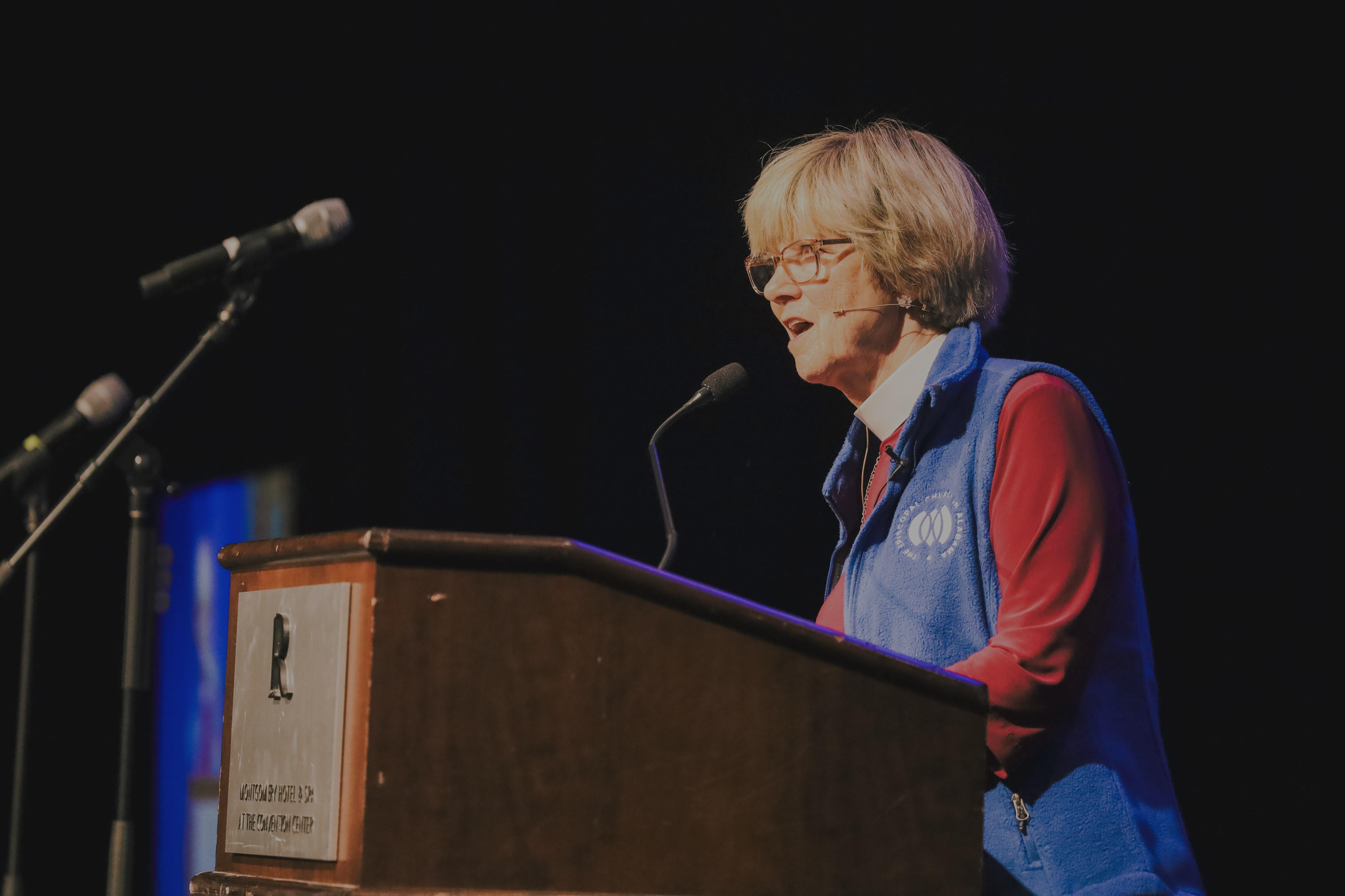

Christian culture, they're outgrowing the rest of the Church of England. Ten years ago, they set a deliberate goal to form 100 new worshiping communities and in seven years they formed 87. Some resemble our small churches, while others are rejuvenated, replanted communities. Some are newly planted churches. There are many ways todoit.
In years past in Alabama, we had a goal to plant new churches where population and need dictated. We drifted away from that strategy. As populations move and change, we need a deliberate strategy for growing. And since the gospel is our primary mission, I believe God is calling us to return to that deliberate renewal, rejuvenation, rebirth, andnewplantingwork.
A small group led by Canon Geoff Evans has organized a bishop's committee and begun the first steps to plant a church community in McCalla called Riverside Church. We've looked at the McCalla area for years, but had not acted. There aren't very many churches in McCalla. I ask your prayers about thisministryofgrowing theKingdom.
We are also exploring identifying something the Diocese of London calls resource churches, where teams and skills for rejuvenating are concentrated and become part of a resource parish's mission. I'm also inviting a teacher who specializes in helping churches to develop small groups that have a missional journey focus. The Rev. Dr. Mike Moynagh will be with us for a week in April. Small group mission equips any small group for outreach with tools to encouragea relationship directlywith Jesus and connect them back toour faith communities.

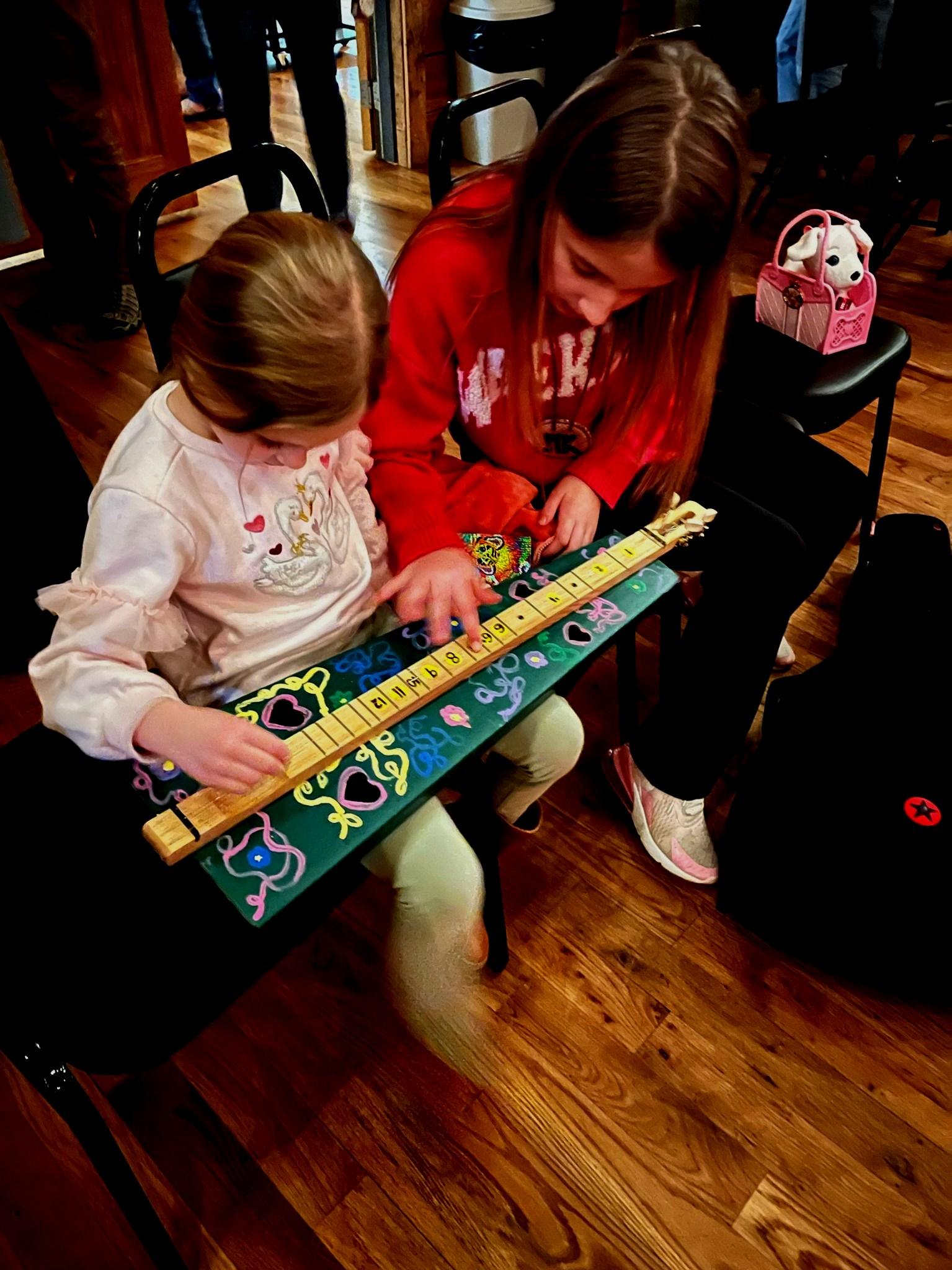




This year weawarded $65,000in grants to20 parishes, an 18%increaseover last year. Projects included everything from backpack programs, English as a second language classes, laundryministry, events for children with disabilities, and food distribution programs and much, much more.
With their $2,500 award, St. Peter's Talladega opened a diaper ministry called Diaper Row. Since last August, theyhave distributed 30,180 diapers and 1,175 pull-ups to 470 guests, helping 650 babies. Thecountyand cityarenowinterested inhelping byhaving diaper drives.
They're now serving eight zip codes with 20 to 30 volunteers from all over, and theydid all that in five months starting with less than $3,000. It's one of the many, many signs of your creative andvitalministry.
Wonderful, wonderful Camp McDowell has returned to pre-covid numbers in attendance and is growing in many new ways. In only three years, thanks to some great grant writing, they have tripled their outside grant funding to nearly $300,000. We hope very soon to name an executive director. Bishop Prior has been a tremendous leader in all of that, along with Whitney MooreShea, InterimDirector.
Last year, camp generouslywelcomed - and survived - theentireEpiscopal House ofBishops for the first time, and the bishops left wanting to come back. 130 Bishops stayed for eight days. Some hadnever been to Alabama before, and some vowed they would never come, but theyleft with changed hearts and they were overwhelmed by Alabama's faith and hospitality. That's only oneofmanynewlargegroups thathaveadded Camp McDowell totheir destination list.
Pilgrimage in Montgomery and Selma and the surrounding area is intense and growing. Things arehappeningallthetimeatSt. John's, and Good Shepherdishosting groups everyweek.
This year, the Jonathan Daniels pilgrimage welcomed over 250people from all over thecountry, along with 28 youth and staff from New York and Alabama for an overnightretreat and a serviceproject at Ascension Montgomery. The youth saw firsthandthatloveis always stronger than hate. We've expanded all our educational opportunities to build relationships around learningabout raceandreconciliation andhistory.
Twenty-six youth from Hale and Green counties, Montgomery and Birmingham spent Martin Luther Kingweekend together atSt. John'sin aPerson2Person event.
This Lent, I hope you'll join me in the One Diocese, One Book online study using a meditation book written byDr. CatherineMeeks, whowill join us.
Richard Ahlquist, Priest-in-Charge, HolyCross, Trussville
JakeAndrews, AssociateRector, Trinity, Florence, andPriest-in-Charge, St. Bartholomew’s, Florence
Pete Burgess, Rector, HolyTrinity, Auburn
Peter Helman, Rector, St. Andrew’s, Birmingham
David Hodnett, Priest-in-Charge, St. Michael’s andAllAngels, Anniston
JaneMajor, Priest-in-Charge, St. Paul’s, Greensboro
Tom Murray, ViceDean, Cathedral Church oftheAdvent, Birmingham
Dean Pinter, Canon Theologian, Cathedral Church oftheAdvent, Birmingham
Adam Young, Canon Missioner, Cathedral Church oftheAdvent, Birmingham
Resolution #1

Sawyerville had a 30th birthday this summer and welcomed 350 staff, counselors and interns along with over 500 HaleCountyyouth and children tothreeweeks ofSawyervillecamp.
Diocesan Budget: PASSED
Resolution #2:
Camp McDowell Budget: PASSED
always steal the show wherever they appear in the diocese, and we cannot have enough gatherings for them. Our youth have returned with energy and wisdom, and here are examples of what theydid in thelast year:
Young adult and campus ministry grew through retreat weekends, fellowship, pub theology, camp, andmanyother things
Campus ministryhas remained activeat four locations around thediocese
Youth from around the diocese attended the Episcopal Youth Event (EYE) in Baltimore, th ofJulyweekend
Our campus ministrygroup convinced us that parish-based campus ministryis reallythemost sustainable model that we can have. Lay chaplains supported by clergy oversight is a new formula, and it is working. God has sent us young adults from 26 different parishes in the metroarea togather aroundcampuses for worship fellowship and tolearn about Jesus.
Our Commission on Ministryis active, and is currentlyoverseeing 16 people seeking ordination. grateful that God has raised them up, and while 16 is wonderful, we could use 16 more. I believe God is raising up people among us for service, but sometimes I think we're reluctant to call it out. Who are your strong lay leaders? Who do you depend on? Where do you see the light
Resolution #3:
ExtraordinaryChristian Witness in Alabama:Referred to Department ofLiturgyandMusic
Resolution #4: Wider Church Assessment
(as amended): PASSED
Resolution #5:
DormancyofParish: PASSED




of Jesus? When I visit, I'm going to ask that question and Bishop Prior is going to ask that question as well. Please join me in praying for Godtoreveal laborersfor theharvest in thisnext year. On another note, a sadder note: from time to time over the 193 years together, a faithful community reaches a place where it's timetoallowtheministryto end. After alongtimeoftrying, Holy Cross, St. Christopher in Huntsville reached this place after their membership declined to four people. And though we grieve with them, we support their willingness to trust Jesus and let go. In 2020 we held a deconsecration for the nave. I've met with them several times, and they all have clergy support. Per our canons, later today I'll introduce a resolution asking the convention to accept thisreport.
Just a few weeks ago, God walked a group called Respite into my office. They helped us begin Founder's Place at St. Luke's, Birmingham and Connect at Christ Church, Tuscaloosa. They are interested in actively partnering with us, to offer this ministry to all of our parishes and to help them form mission to support persons with memory loss. This ministry is one that any church, regardless of size, can do without a lot of resources, andtheyhave a grant process and they will help you get seed money and training.
Theneeds areextraordinary, and God is calling us to respond. All this ministry is an expression of God's willingness to work through us and with us. And everyone is a gift. Everything we have and everything we are is a gift from God. If we can make God the subject of everything we do, that is the truth in love spoken out loud. I'm grateful for how you cooperate and encourage each other in ways that I don't even see, and I see a lot of ways. How you're sharing your ideas, how you're sharing your talent and your money. It's all for God's glory. With all that God gives us, your generous hearts make it possible. You continued through these years to give faithfullyand sacrificiallyto your parishes and tothediocese, tosupport mission andministry.
When average Sunday attendance went down, when membership slides, your giving goes up. When I saythank you, it doesn't seem like enough. Through the pandemic and social strife and uncertainty and tragedy, which we've weathered more than once, you have given financially over and over to help the kingdom grow. And I am deeply, deeply, grateful, to you and to God for your generosity. You teach meconstantlyabout resilienceandstubborn faith, and mostly about love. I hope you can see and hear that our church is healthy right now, and yet challenged to work faithfully to reach both inside and outside our walls to share the love of Jesus.
None of our challenges will get easier. And while we'll always want to make every resource multiply, and continue to provide strong leadership, support creative ministry, especially in our small churches, provide more Refresh and Renew opportunities,
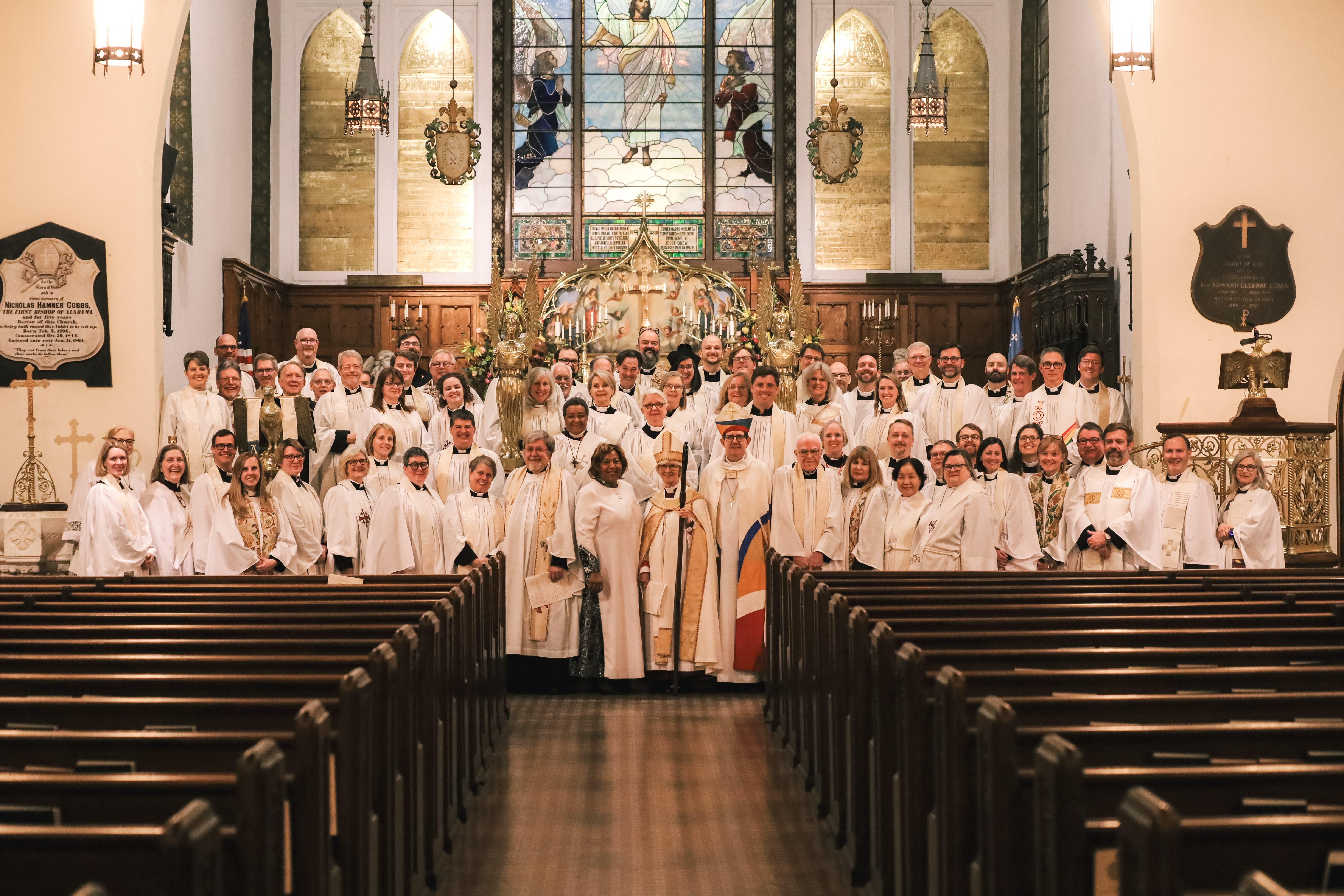
encourage growth and build up the body, we will need a way to sustain support for our ministrytogether. I believe God is calling us tobuild that support now to provide for a thriving ministry for our babies and their babies, maybe a hundred years from now. To that end, the feasibility studythat I mentioned last year was completed last spring, andDiocesan Council endorsed their findings for a three-year capital campaign called Equipping the Saints. The goal is toraise $7.5 million to support congregational vitality and leadership development, racial healing and pilgrimage, and Camp McDowell. Please join me in praying for co-chairs Will and Liesel French and Tom and Cornelia Heflin, and for this campaign as it unfolds.

Last year our keynote speaker told us toremember that God's gifts are not for God's people. They are through God's people for everyone else. God's gifts are the sort you cannot keep. You have to give them away and they always replenish. Last night, our preacher told us to have the audacity to dream and to have God-sized dreams. She reminded us God wants to bless us through good and bad because God is sovereign and good. I pray our God-sized dreams always reveal the saving love of Jesus that is open to us all, and to the world in all we do. Thank you.
*Peterson, E. (2013). Practice Resurrection: A Conversation on Growing Up in Christ. Eerdmans.




There is a myth that is pervasive at all levels of the Church - we are dying. Week in and week out I witness this myth being busted as I witness the incredible ministry happening regardless of the size of either the parish or the community. During the announcements, inthecoffeehour andinvestrymeetings Iget to experience the 'show and tell' of the wonderful ways folks are engaging in God’s mission-intheneighborhood, inthecommunity, intheworld.
“Forwheretwoorthreearegatheredinmy name, thereamIamongthem.”
Matthew18:20
“ForIwashungryandyougave mefood, I wasthirstyandyougavemedrink, Iwasa strangerandyouwelcomed me, Iwasnaked andyouclothed me, Iwassickandyouvisited me, Iwas inprisonandyoucameto me.”
Matthew25:35
For me, these two passages from Matthew articulate the amazing ministry that happens every day across the Episcopal Church in Alabama. Sometimes it is parish-wide, sometimes it’s a small group, sometimes it’s in partnership with others but always we are feeding minds, bodiesandsouls.
I do a lota workacross the Episcopal Church and one of the questions that Iamconsistently asked is, “What does vitality look like?” My first response, "It looks like love." My second response is the above two passages from Matthew. And my final response is a story (one of many I could pick!) about one of our parishes in the Episcopal Church in Alabama following Jesus in God’s mission. Suchablessing!
-BishopBrianJake Mulder is the Senior Director of Strategy at the Fuller Youth Institute (FYI) and Fuller's Executive Director of Leadership Formation Division, and the author of the book Growing Young.He's passionate about helping individuals in churches do whatever they can to support congregational vitality and is very energized and focused on the next generation. He addressed convention in two sessions, and also spent timewith theYouth Department.
Jake began his first address on Fridaywith this statement:
“I want to begin with what I think is a fairly bold claim, but a posture that I think we have to hold if we are going to be able to move forward in this work. Itis this: thebest days ofthe church arein fact ahead ofus.
I hold this perspective for a few different reasons. On one hand, I am an optimist and like to look at the bright side. I don't know how you can follow the way of Jesus and not hold this perspective. When we pray the Lord's prayer and Jesus invites us to pray that God's kingdom would come and that God's will would be done on earth as it is in heaven, I don't know how there's any way that you can pray that prayer and hold to it unless you have an expectation and a belief that God will do what God has said that God will do.
I also hold this perspective because I get to interact with enough ofthenext generation and younger people and see so many bright spots and amazing signs of hope that I refuse to believe that God has done something once and then said, well, I did that. I think I'll just leave them alone over there and hopefully it turns out okay. I believe that God is a God of resurrection and Jesus offers us hope, andtheHolySpirit is doingnewthingsin Alabama andin the Episcopal Church, and in all sorts of other traditions and parts of our countryand parts ofour world.”
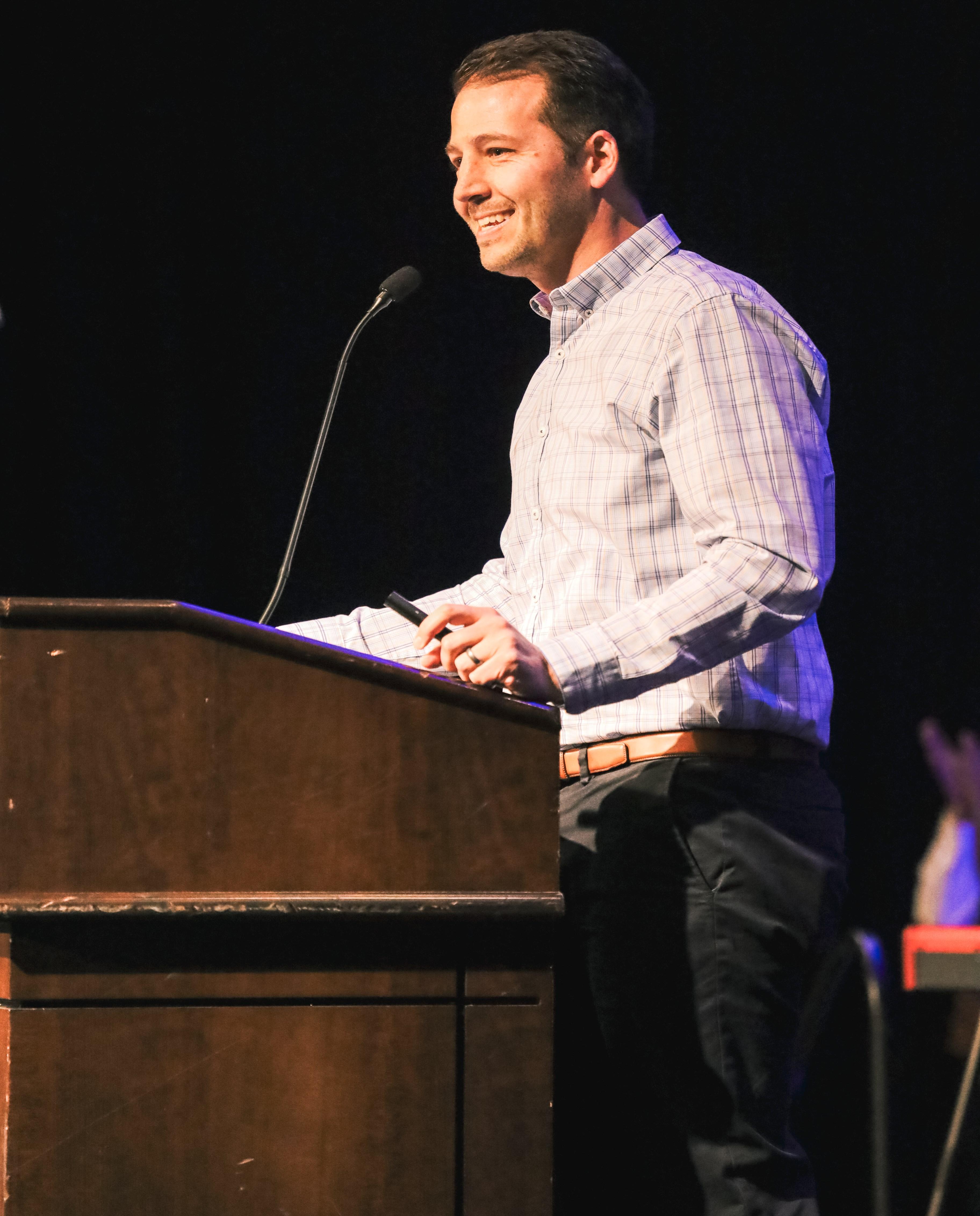
4. Sometimes we may assume it's the nondenominational churches or the evangelical churches or the fill-in-the-blank churches that are engaging young people. Jake and his team found congregations in mainline traditions in the Roman Catholic Church and many others that are successfullyengagingteenagers andyoung adults.
The team at Fuller conducted about 1300 interviews and spent about 10,000 hours of research time analyzing thousands of pages of interview transcripts. The premise of the growth of modern churches based on research done at Fuller includes a list of four things you don't have to have if you'regoing togrow young:
1. Youdon'thavetobecomealarger churchtoengageyoungerpeople.
2. There's nomagiclocation or region whereyoung peoplegotochurch.
3. Sometimes we have the assumption that an older church is going to struggletoengageyounger people. Researchers found churches well over 150 years old that wereengaging young people.

ou’ve got to learn to cook from the fridge,” Sally Gaze declared with a warm smile. Her pale blue tweed jacket and heavy plaid skirt with tights showed she was well prepared for the chill of January in London. Sally serves as theArchdeacon for Rural Mission for theDiocese of Suffolk. Prior to this role she had been a priest serving in rural parishes. She was our second speaker of our first day. While she was unassuming in her presentation, she would offer some words of deep wisdom that I carried with me over the next several days of“Learningfrom London.”
“Learning from London” is a course offered through Bexley Seabury Seminary, which is an Episcopal Seminary based in Chicago offering hybrid formation for all orders of ministry. The Rev. Dr. Jason Fout serves as the creator of and instructor for the course, which grows out of his research. The premise for the course, as outlined in the syllabus, was simple:
Since 1993, the Diocese of London has grown around 70% in terms of regular attendance, giving has more than doubled, and the diocese has been at the forefront of church planting among Anglican churches in the developed world. Thisisverymuch a"Manbitesdog"headline! So many of us have become accustomed to loss and decline, resigning ourselves to it, telling ourselves that we now live in a post-Christian, secular, multi-cultural, multireligious, cosmopolitan setting, and that tells against growing churches. But here's the thing: London is moreofallofthose . And they've grown. So, what can welearn from them?
Searching for an answer to that question, I joined Bishop Glenda Curry, Jordan Rippy, and the Rev. Jack Alvey for the January 2024 cohort of “Learning from London.” This iteration of the course was geared towards bishops and diocesan leaders. While our focus would remain on London, the scope of our conversations would broaden to include leaders working in rural areas, such as Sally Gaze.
So here are a few things that I learned from mytime in London.
Sally Gaze offered this remark in concluding her presentation on rural ministry. Her metaphor was simple, dinner had to be made and there is not always time to pop over to the grocery to get special ingredients. Often you just must open the fridge and the cupboards and use what is there. Sally’s obser-
vation is not so much about making do with less but is about realizing the abundance of resources (people, gifts, opportunities) that are already at hand. It is an invitation to move from an idea of scarcity into a new appreciation of abundance.
Sally now leads Lightwave, a Christian communityfocused on shiningthe light of Jesus in rural areas. They meet in small groups and are involved in combatting isolation and poverty, engage in youth work, care for creation and agricultural chaplaincy. Each group is built on five practices:
All Involved - Everyone is included and valued, whoever they are. Everyone hasa role toplay.
Becoming Disciples - The purpose of the group is toencourage us tolove and live more like Jesus.
Creating Community – The group will “bereal” with each other - honest about the things we go through ourselves and to respond in a loving way to each other. Caring for each other enables us to care for our wider communitytoo.
Doing Evangelism - Being as well as telling good news together. Giving other people the opportunity to learn about Jesus.
Encountering God - Meeting with God. It is God whohelps us andchanges us.
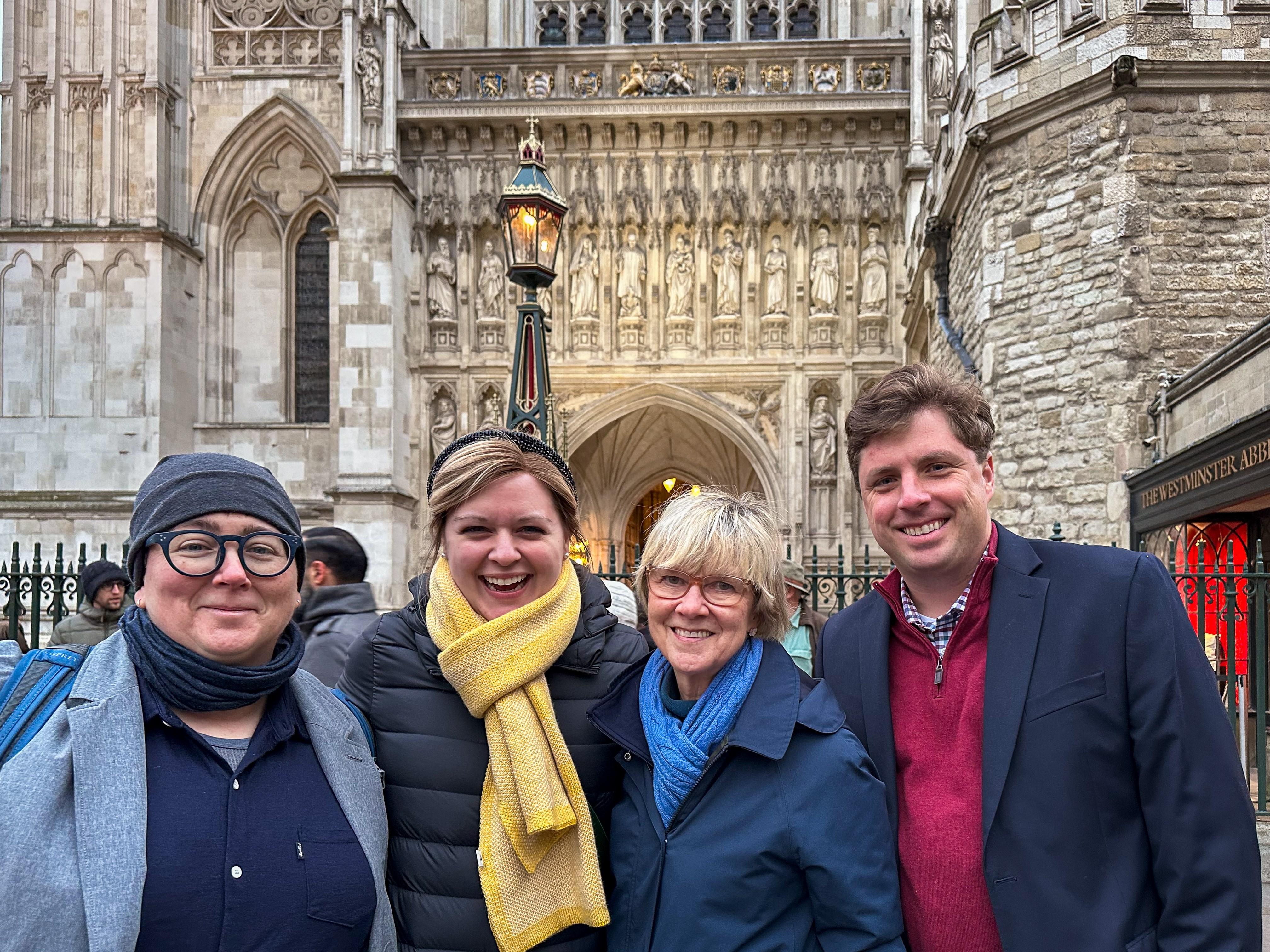
Fr. Richard Springer greeted us outside St. George’s in the East and ushered us downstairs to a sitting area. We hung our coats and took turns receiving hot tea or coffee, before finding a seat to hear their story. The parish was built in the 19th century and bombed in the blitz. A new worship space was created from the ruins in the 1960s. By the 2000s, membership diminished to 20 or so. A change in leadership provided an opportunity for a creative partnership with The Centre for Theology and Community, which located its offices at the church. Using community organizing principles, St. George’s built the parish communityand connected in new ways to the neighborhood. This led to growth in the Sunday service and allowed the calling of a new rector (Fr. Richard). As the numbers grew, St. George’s became a resource parish and sought out new expressions of faith, including a Choir Church, The Open Table (worshipping with the homeless people), and a Portuguese-speaking

congregation.
Fr. Richard described St. George’s as a modern Anglo-Catholicparish centered in theEucharist, “which gives fuel for a week that we don’t yet know about.”
Theyarea communitythat understands that power is not finite and that it matters who gets to speak and be heard. Most of the growth in the parish comes from people who live within walking distance to the church and have encountered St. George’s at work in the neighborhood. Fr. Richard remarked that St. George’s had been the sort of parish that a priest served while on the way to a bigger church. For him it is important torecognize and value the good in the placeheserves.
When Phil Williams walked up to greet the group outside of St. Paul’s in Shadwell, he was certainly not who I expected to be leading a charismaticevangelical church that was part of the Holy Trinity Brompton network. Phil was stocky and in jeans, bundled up against the damp cold. As we walked through the church and grounds, he explained that
St. Paul’s was the church of the sea captains. Established in 1656, seventy-five sea captains were buried there. John Wesley preached there. Jane Randolph, mother ofThomas Jefferson, was baptized there. Walking into the Georgian church, we were greeted byan open plan design, children’stoys, anda central stage. On a wall of the sanctuary hung a bulletin board that named and briefly described the churches that St. Paul’s had planted. The parish itself was replanted in 2005, led byRicThorpeand a group from Holy Trinity Brompton. As the church flourished, it became a resource church. As described by (now) Bishop Ric Thorpe, aresource church “is designated by its bishop to be a church-planting church which trainsleaderstoresourceand supportmission acrossa diocese.” Phil explained that St. Paul’s had planted eight churches, and two of those church plants had goneon toplantchurches.
In themeetingroom ofthechurchhouse, hands being warmed by hot tea or coffee, Phil explained that the vision of St. Paul’s includes church planting. This means that the church intentionally raises up and re-
outside of Westminster Abbey following Evensong, January 14, 2024, (L TO R) CANON Kelley Hudlow, Dr. Jordan Rippy, Bishop GLENDA CURRY, and Rev. Jack Alvey.
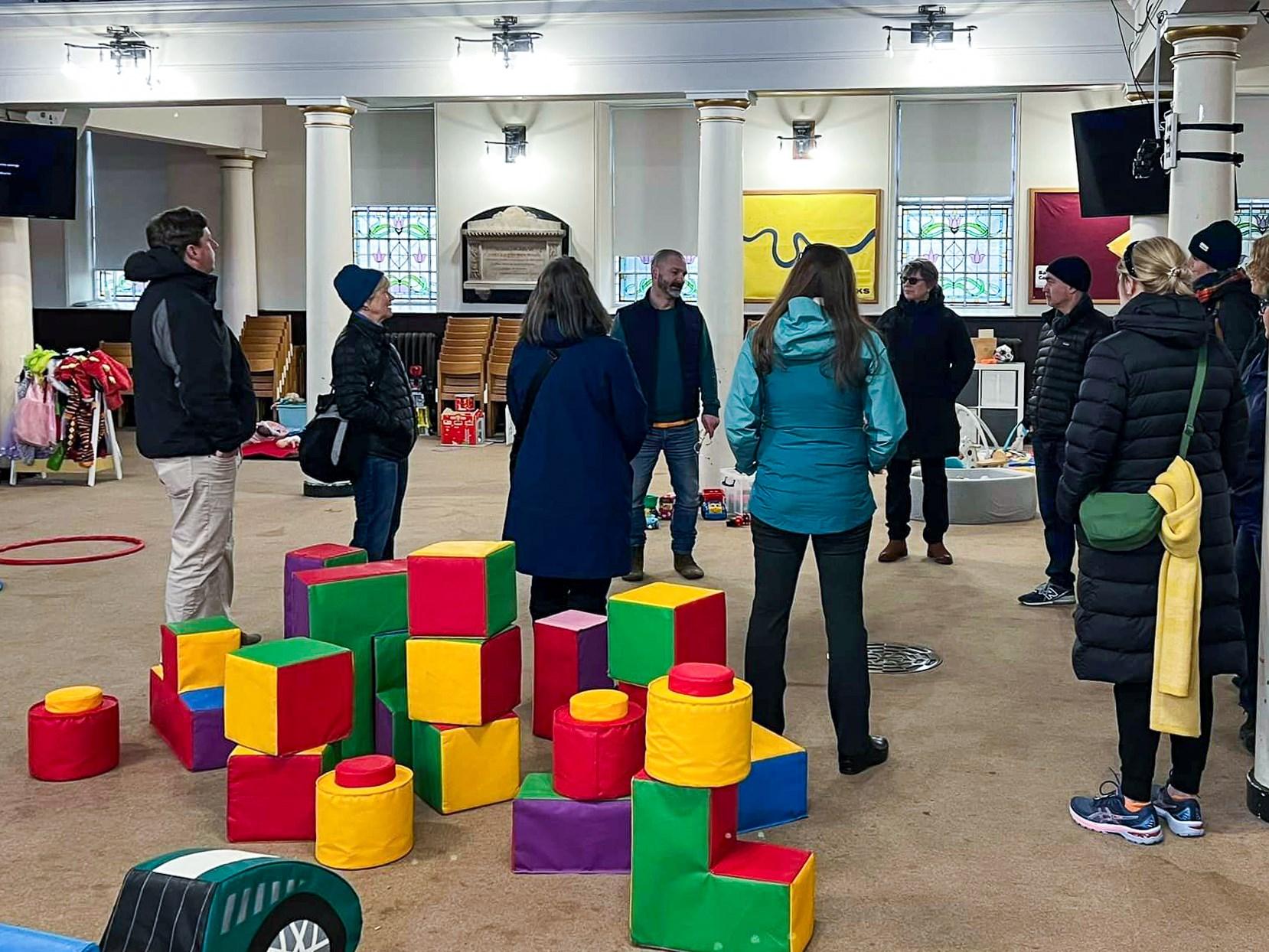

leases leaders (lay and ordained) to plant churches. In the past ten years, St. Paul’s supported 30 people in the ordination process. Phil admitted that sending leaders out can be painful and cause grief, but hetrusts that the Holy Spirit will move and create something new. Reflecting on the fact that St. Paul’s will soon plant another church, meaning more leaders will be sent, Phil explainedthatthecallwasto“giveawaytheir best.”
The Old Deanery, across from St. Paul’s Cathedral, houses the offices of the Bishop of London and the Gregory Centre for Church multiplication. Our host, H Miller, explained that the portraits on thewall wereall of bishops that had someproblematic stories, so they were hung here in the basement. It is here that wemet Fr. Ross Gunderson, aScotsman and church planter dressedin athree-piecetweed suit.
Fr. Ross told us that when he arrived in the fall of 2018 at St. Etheldreda’s, nicknamed “St. Eth’s,” there was only a small group of people regularly attending worship. Fr. Ross began to search for ways toopen thechurchtotheneighborhood. Aplaygroup was started. He announced a Christmas Carol service with goal to fill the church, which they did with 400 people attending. Numbers at regular Sunday services where smaller, but for major observances they were able to create meaningful Anglo-Catholic worship that connected to the community. When the pandemic closed the churches, St. Eth’s became a neighborhood charity, delivering food and medicine. They maintained an online presence and grew. Post-pandemic, St. Eth’s partnered with a local school and continued to deepen their connection withthecommunity.
Fr. Ross identified some key practices of St. Eth’s. Going outside the walls of the church as much as possible. Setting targets (and celebrating making them). Keeping the church doors open constantly. Embracing diversity of leadership and growth. Understandingthatthesacramentsaretheessenceofthecommunity of St. Eth’s. Remarking on his early days at St. Eth’s, Fr. Ross said, “I decided to not be afraid and to just believe that everything waspossible.”


theidea ofchurchmultiplication. Thisislanguagedeveloped by Bishop RicThorpebased on descriptions ofthedevelopment of the early church in the Book of Acts. The Centre seeks to help leaders and communities to engage intentionally to multiply Gospel-sowing, disciples, leaders, and churches. Themission of the Centre is to help the Church reach new people, in new and renewed ways, which supports the Diocese of London’s vision to encourage every parish to start something new to reach new people. Theydo this through offering theGrow Course, leadership development, and coaching. Theintention is that each new communityor offeringthatisplanted, willgrowandinmultiply tocreatesomethingnew, too.
Starting new missional communities toreach new peopleis not just confined totraditional worship services or parish programs. We were introduced to theRev. Dr. Mike Moynagh, wholeads the Greenhouse for the Church of England. The Greenhouse helps support the creation and leadership of missional communities, a.k.aFresh Expressions, byofferingalearning community and guidance on the missional journey. The Missional Journey keeps teams focused and intentional as they work towards their mission goals. The Journey is a cyclical process that begins with listening to the context and to God. The team then discerns a simple way to love the people around them, and in doing sotheybuild community. In thecontext of theserelationships, theteam shares theGospel in a waythat is appropriateto the context. As people grow in their faith, gradually a worshipping communityemerges that is connected tothe wider church. Then thenewcommunityrepeatstheprocess.
Now for the obvious: the Church of England is different from the Episcopal Church. The UK is different from the USA. We learned a lot of technical things about ecclesiastical structure, pay structures, property, and taxes. Folks seem to get bogged down in the details of centralized salaries, the National Health



Service, and establishment churches, and these technical differences become stumbling blocks to witnessing what God can do because these differences involve things beyondour control. But there are a few things about being the established church that we can learn from. The Church of England has not had a new official prayerbook since 1662. Common Worship exists on the world wide web, and it wasn’t until our last day of the course that we were in a church with bound hymnals and lectionary. This means that being Anglican is less about a certain liturgy and more about who you are connected to. This has allowed a diverse array of worship to grow, from charismatic evangelicalto Anglo-Catholic. Perhaps building on thediversityof worship expression, theChurch of England has been able to embracea “mixed ecology.” Thismixed ecologymeans that they seek to nurture varied models of ministry: parish churches, cathedrals, Fresh Expressions, lay led congregations, resource churches, network churches, chaplaincy, diaspora churches, andchurchesthathavenotyet been imagined.
I will end where I began, with wisdom from Sally Gaze. Amidst all the wisdom she was sharing, it would have been easy to overlook this comment: “Make God the subject of the sentence.” When she said it, I quickly jotted it down in my notebook because it intrigued me. As I went through my week in London, I noticed how each person we met talked. They shared about their ministry, their church, and their context. They also named what God was doing in their ministry, their church,andtheir context.
Each person expected God to act, to call, to grow the community. Their languagewasnot forced, but instead expressed their authentic, deep faith. They spoke of a God that was not a passive observer, but instead was an active participant that demandedtobethesubject ofthesentence.
Mytimespent learning from London sent mehomewith questions for theEpiscopal Church in Alabama. Whereis theSpirit leading us? What is God doing/making/transforming in our lives, our ministries, our churches, andour communities?

A few examples of “making God the subject” from Kelley’s Learning
from London notebook:

Fr. Ross Gunderson, St. Eth’s, Fulham: “God calls us to be us, not someone else.”
Rev. Sue Hughes, a Pioneer Priest in The Greenhouse: “God is beginning to give me the imagination for my context and my faith.”
Rev. Dr. Mike Moynagh, The Greenhouse: “Relax and let the Spirit lead.”
Rev. Phil Williams, St. Paul’s, Shadwell: “The gift of a secular culture is that it must be God making the growth. We create space for the Holy Spirit to move.”
Themost “famous” Alveytoservein the Church ofEnglandwas named RichardAlvey. Richardheld several distinguished positions in his own rightincluding servingasa canon toWestminsterAbbeyas well as the Master oftheTempleChurch in London. TheTempleChurch was thehomeofthe KnightsTemplar (think DaVinci Code). Both positions wereroyal appointments.
Richard’s claim tofameishis proximityto another Master oftheTemple. Considered Apparently,Arthur andhis Churchwardens werecited for allowing cockfighting in the chancel on ShroveTuesdayin 1634, 1635, and1636. Ithas been suggested thatthese cockfightingmatches served as an ill-advised fundraiser torepaya loan used tobuild the newbelltower.ArchbishopWilliamLaud ordered that chancel gates be built and locked at alltimes except during divine worship.


the 16th and 17th centuries. Thanks to a few Google searches I was able to find biographical information on three of these Alveys. It didn’t take long for me to move a pilgrimage to England to the top of my bucket list, and I was thrilled when asked to be part of the diocesan Learning from London group. While on the trip I learned more about two of them: RichardAlvey(the“famous” Alvey), andArthur Alvey(the“infamous” Alvey).
Whileit mightbeabitofa stretch, you mightsay that Rev. Arthur Alvey(seesidebar on the left) was a pioneer ina movement that we now callFreshExpressions.Onedefinitionsaysthat afreshexpressionisagospelcommunitywherelifehappens. Afreshexpressionmightbeformed inacoffeeshop,atatattooparlor,atthegym -oratthelocalcockfightingring!
ApioneeroffreshexpressionsinourlifetimeistheRev.Dr.MichaelMoynagh.Hedrawson the faith revealed in the miracle of the fishes and loaves. Simply stated, he says, “start with what you’ve got and trust the Holy Spirit.” This movement is built on the fundamental theological claim that mission starts with God and the belief that God has given us all that we needtoproclaimthekingdomhascomenearinJesus.
The Rev. Dr. Sally Gaze, Archdeacon of Rural Mission in the Diocese of Suffolk, compares the fresh expression movement to cooking fromthe refrigerator. Like rural America, rural England often lacks the same kind of human and financial resources that many cities canaccess. This supposed scarcity makes roomfor the creative work of the Holy Spiritand a trustinthesameGodwho multiplies theloaves andfishes.
Around three-quarters of these fresh expressions are lay-led. This is a critical component to the movement as clergy areexpensive and these (usually) smaller communities cannot provide financial support. In addition, many of these communities are formed in spaces that
have been skeptical of the church and clergy. In a “post-Christian” culture, lay people are often better able to provide a more credible witness tothe gospelthanclergy.
Recognizingthis trend, MoynaghbegantoformwhathecallsGreenhouses. TheseGreenhouses providea supportnetworkforlayleaders who are leading or interested in leading gospel communities where life happens. The lay leaders meet regularly with others who are doing similar work and have facilitators who are often clergy. In addition, theseGreenhouses help the laity reflectand articulate their faith in their own words in a church that has traditionally scripted the words offaithinthe Book ofCommon Prayer.
These gospel communities begin when an individual or small group recognizesaneedinthecommunity. Slowly, asmallcommunitygathers around this need. At some point, Jesus is introduced, and discipleship is explored. Beforelong,thecommunitybeginstogather foraprayeranda meal. Suddenly, a church or worshiping community is formed. To hear stories about these communities, I highly recommend a book by Moynagh titledBeingChurch:DoingLife:CreatingGospelCommunitiesWhereLifeHappens.
As many have been saying for years, there isn’t a silver bullet to reverse the trend in church decline. Leaders in the Church of England often use the phrase “mixed ecology” to describe the success of church growth. Leaders trust that the Spirit is renewing big churches and small churches, liberalchurches and conservative churches, high churches andlowchurches,andchurches everywhereinbetween.
Another major renewal movement in the Church of England began much like a fresh expression. In the late 1970s, a curate serving a large parish church called Holy Trinity, Brompton developed a course for new church members called the Alpha Course. This 10session course evolved into a course that is meant to attract the unchurch or de-churched. Each session centers around a meal and is oftenledbyseverallayleaders.
As Holy Trinity, Brompton grew, they discerned a need to walk alongsidestrugglingchurches andhelpthemrevitalize. Inorder todo this, the most active members were commissioned to go and help plantorre-planta church. UsinglanguagefromtheAlabama Planfor Stewardship, this movement employs first fruits, proportional, sacri-
ficial giving when it comes to sending church members out. Simply, theysendtheirbest.
Eventually,bishops caughtontothesuccess ofHolyTrinity, Brompton and formalized this movement as the Resource Church movement. A Resource Church is an official designation given by the bishop which empowers churches to raise up future clergy and lay leaders whowillgoontoplantnewchurches.
The vision of resource churches is simple. They plant churches that plant churches. In a strategic plan formalized in 2013 called Vision 2020, the Diocese of London set out to create 100 new worshiping communities. They nearly met their goal and established 87 new Christian communities. Like anything that didn’t go as planned in 2020, they blamed COVID for preventing them from meeting their goal!
If you want to learn more about the Resource Church movement in England, I highly recommend Resource Church by The Rt. Rev. Ric Thorpe who is now a suffragan bishop in the Diocese of London. Bishop Thorpe was raised up by Holy Trinity, Brompton and is now in chargeofchurchplantinginLondon.
While the methods of church growth and management vary significantly between places like St. Margaret’s Knotting and Westminster Abbeyand Holy Trinity, Brompton, I’d like to offer three underlying assumptions all Christian leaders should make about congregational growthandvitality.
Firstand foremost, the Spiritis at work in every contextand moving every Christian and community to be a part of the salvation project fulfilled in Jesus Christ. Next, by gathering the community around Jesus through his Word and Sacrament, God is expanding our vision ofwhatis possibleasthekingdomofheavenhas drawnnear.Finally, if we say we have faith in a God who raises even the dead to life, then words like “impossible” or “never” cannot be a part of our vocabulary.




Serving God and broadening the horizons ofparticipants and staff is at the core ofSawyerville's missionas it partners with Hale County. Thethird mission is the embodiment ofthe first two:to improve race relations inAlabama. InallofSawyerville’s programming, campers, students, participants, and staff are taught to love one another with no exceptions, as Jesus loves us, andto respect the dignity ofeveryhuman being, as our Baptismal Covenant requires. Everyyear, Sawyerville hosts Person2Person, a weekend conference for high school and college students fromall over the stateto come together to learnabout the historyofrace inAlabama. Participants also talk about their own experiences ofrace, and discern, as Christians, what theycando to improve race relations now.
This year, Person2Personwelcomed 29 participants and staff, one ofthe largest groupsto date. Over MartinLuther King Jr. weekend, these highschoolstudents, college students, and adults traveled to Selma and Montgomery, visiting historical sites and museums significant tothe Civil Rights Movement. These sites included the Edmund Pettus Bridge, the NationalVoting Rights Museum and Institute, the FreedomRides Museum, the Harris House, and EJI’s LegacyMuseum and NationalMemorial for Peace and Justice. The group also toured the EpiscopalChurch of the Good Shepherd, led byRev. LarryYarbrough, and attended Sundaymorning worship at St. PaulAME Church. Person2Personwas hosted byCommonGround ofSt. Paul’s, Selma and St. John’s, Montgomery. These churches not onlyprovided housing for participants and staff, but also provided a space for debriefand discussion, which proved to be some ofthe most impactful discussions the group had.
Sawyerville looks forwardto seeing these young people continue the conversations
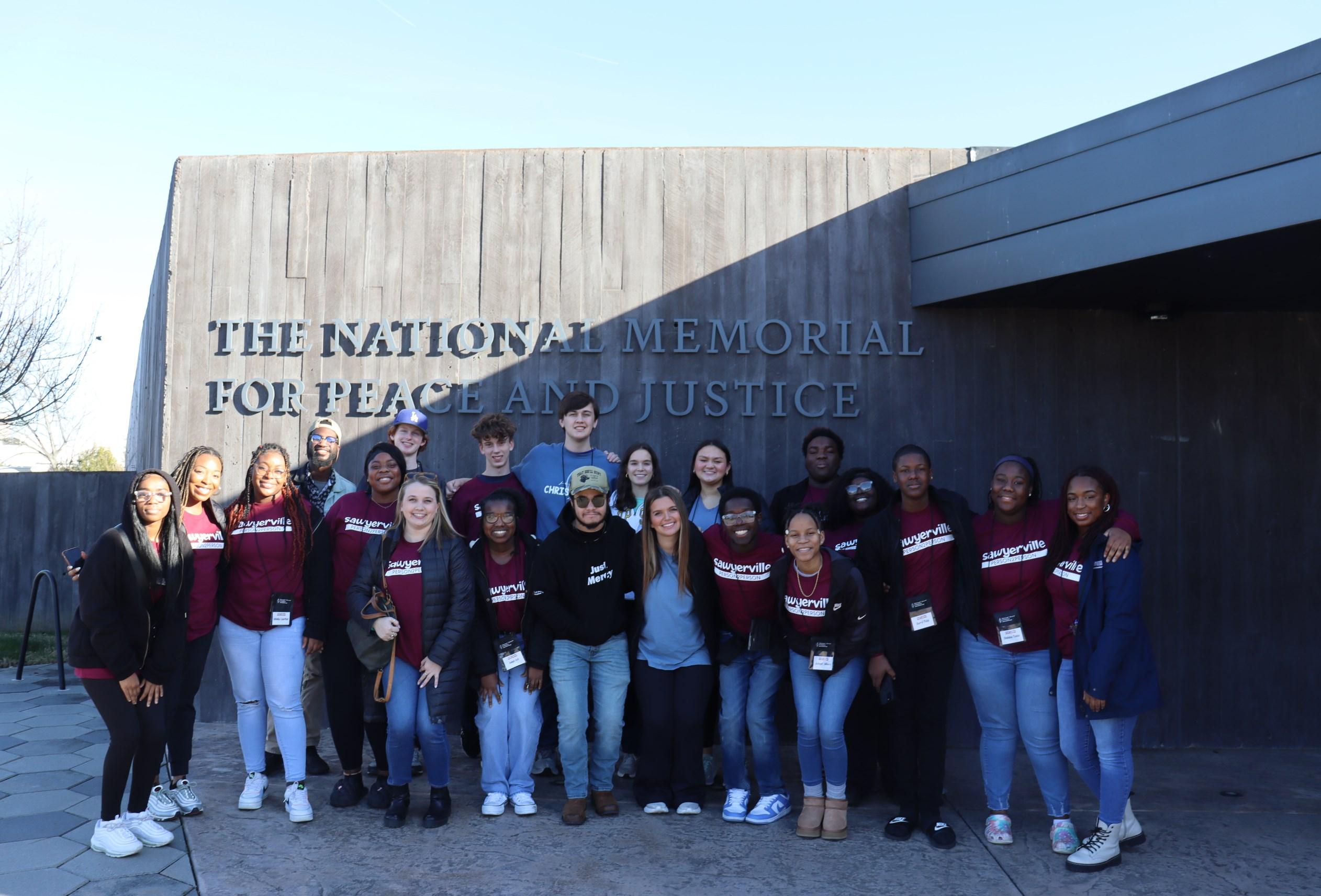
Carrie Dennis, Assistant DirectorofSawyerville

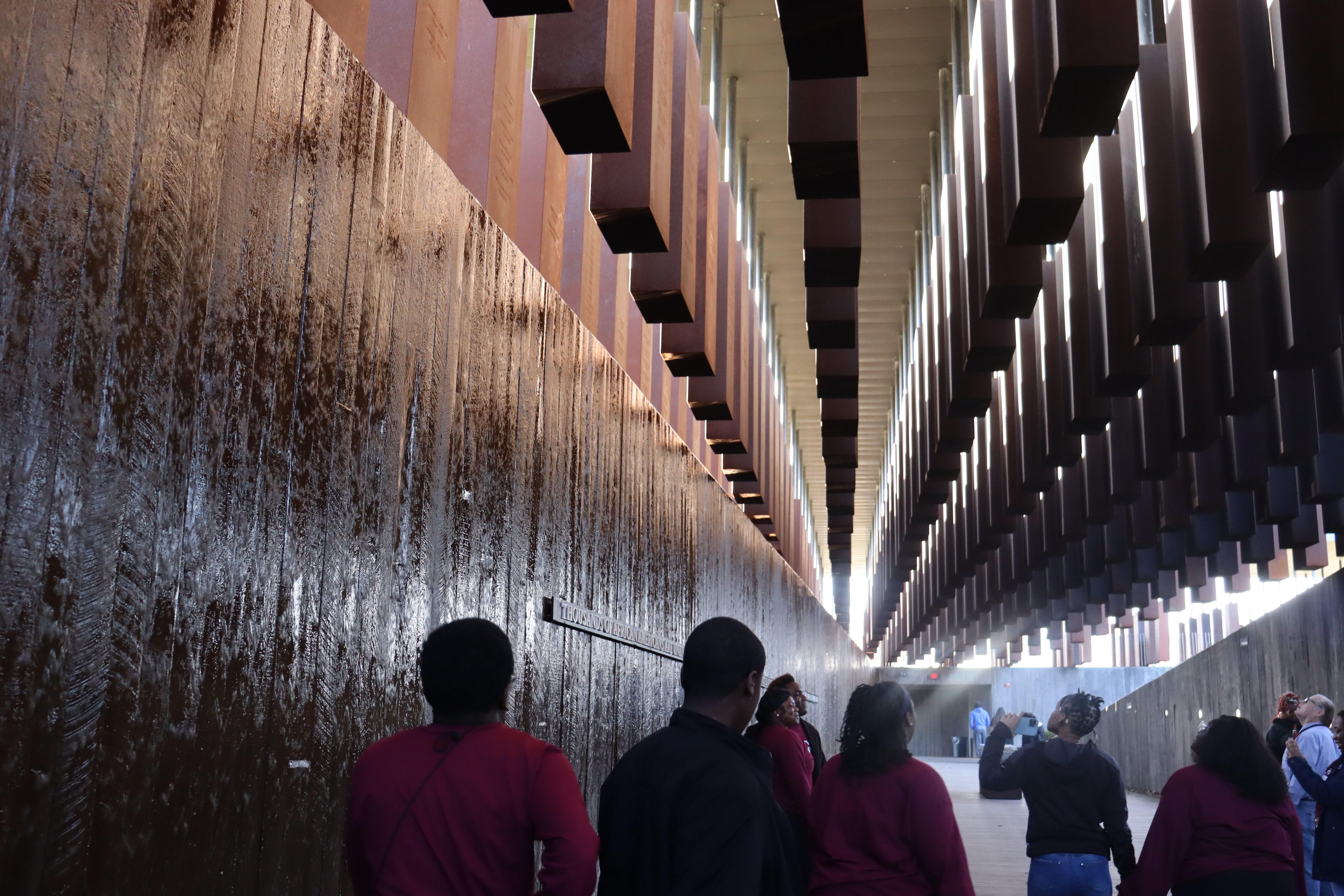
 LEARN MORE ABOUT PERSON2PERSON BY SCANNING THE QR CODE
LEARN MORE ABOUT PERSON2PERSON BY SCANNING THE QR CODE







In thenameofGod theFather, theSon, andtheHolySpirit. Amen.
My name is Lillie Hartley, and I am the Chair of this year’s Youth Department.
Tasteandseethat theLord is good. Tasteand seethat the Lord is good. Hmm.
This group of people described in today’s New Testament lesson is one of the earliest and bestexamples of a Christian community. This group this community believed they were one of heart and soul. To them, no one claimed private ownership over anything; everything they owned was held in common. They tasted and saw thattheLord was good.
Camp McDowell… I bet you saw that one coming. I have been attending summer camp at Camp McDowell for most of mylife, this past summer being mylast. Over the years, I have made some wonderful friends and have met some wonderful people. However, it wasn’t until about high school that I realized what I had right in front ofme. I had acommunity. A loving, caring, selfless community. At camp, it seems like almost everything is shared. First of all, we share a living space for a week up to 10 days. We share snacks, which, as a teenager, is a bigdeal . We share shirts, shorts, dresses, ponytail holders, and oneof the most important… makeup. Let metell you a quick story. While at camp this summer, we had what's called a pasture party. It’s on the second to last night ofcamp, andit's major. Everyonedresses up in cute outfits, and for thegirls, thatusuallyincludes makeup. Now, to be veryhonest with you, I don’t knowhowtodo makeup. After expressing this to my cabin, one of my closest friends, Merritt Fulmer, offered to do my makeup with hermakeup. Now I know this may not seem very significant but the sharing of makeup is personal. Not only was she using herpersonalmakeup on me, she was also taking the time to do so. To me, Merritt’s actions werean expression ofcommunity.
As I mentioned earlier, I am the Chair of the Youth Department. One of the most crucial ways that the Youth


Department remains a unified team is the way we make decisions together. Instead of voting, we communicate as a group to come to a unanimous consensus, considering everyone's concerns or comments before moving on. For example, we needed to come to a consensus on a theme for our longest and most-attended event, Christmas Conference. While discussing this theme, we needed to consider program, activities, and T-shirt designs. To make a long story short, we did come to an agreement on a theme – “Home for the Holidays.” However, we were only able to reach that agreement by listening to each other with open minds. We came together as a communityandacted as a unit, “oneofheartand soul.”
Another community that I am a part of is Special Session. Special Session is a summer camp experience for adults with disabilities. Shameless plug here Special Session staff applications are currently open! This summer will be my 3rd summer on staff but 10th summer participating. The directors of Special Session refer to Special Session as gumbo. Gumbo is a popular, cajun stew filled with a myriad of different, delicious ingredients. Even though gumbo is a mixture of various components, together, it’s one harmonious dish. And that is Special Session thatis community, “one of heart and soul.” Special Session is a prime example of one of the ways that ItasteandseethattheLord is good.
Finally, some ofthegoodness oftheLord is thattheLord provides us with community. The Lord provides us with a group of people in which we all belong no matter if we are okra or rice because we will still make gumbo. Friends, we are participating in community right now. Every single one of us are leaders in the diocese in some way, shape, or form, and we all came together this weekend to make decisions together as a group as a community, “oneofheartand soul.”
So here’s my challenge for you… go out intoyourcommunity, share some ofyourmakeup, listen to others with an open mind, andaccept everyone whether theyareokra or ricesothat you just might tasteandseethat theLord is good. Amen.



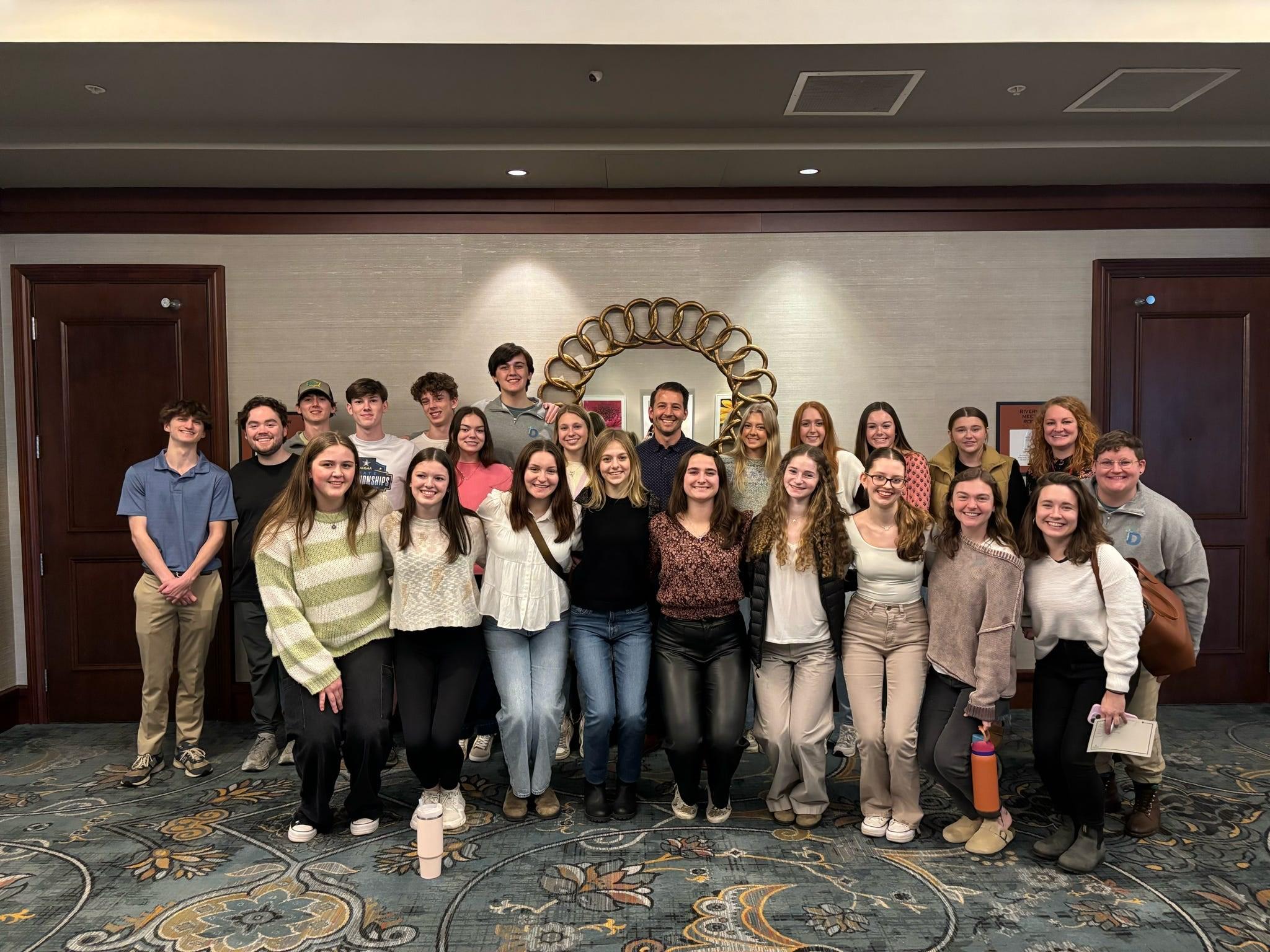
Ann WesleyHarrison - St. Luke's, Birmingham
Eleanor Couch - All Saints, Birmingham
Harrison Meyer - HolyTrinity, Auburn
CatherineLamm - HolyTrinity, Auburn
MaggieRedding - Trinity, Florence
CarolineOdom - St. Stephen's, Birmingham
Robert Bradford- St. John's, Montgomery
Finola O'Halloran - Nativity, Huntsville
MargieAnn Prescott - Ascension, Montgomery
Lauren Behm- ChristEpiscopal, Tuscaloosa
AnneHarman Hornbuckle - All Saints, Birmingham
Ann WrightCarlson - All Saints, Birmingham
In between Christmas and New Year’s Eve, the Youth Department hosted our annual Christmas Conferenceat Camp McDowell.
Over 120 high school campers and 40 college-age and adult staff came together for a program hosted by Rev. Michael Goldsmith from Nativity in Huntsville called “Home for the Holidays”. We had an amazing (and very cold) time learning, worshiping, andplaying together.
We received a lot of great feedback from campers and staff on the evaluations, and feel proud of the event that we put together as a Youth Department. Some highlights included program and small group time, games like Santalope, a surprise New Year’s Eve party for the campers, and Advent/Christmas themed worship written andled bytheYD.
We also had two outreach projects for the weekend:
1) We collected a ton of toys, blankets, and beds for animals in shelters and 2) We were able to donate over $200 to the Camp Scholarship fund from donations through our closing Eucharist offering.

This is an annual gathering of youth and adult youth workers from dioceses in Province IV. We gather to hear diocesan reports, learn about new activities and programs, and spend time in fellowship and community with one another. Our reps learned leadership skills from peers, learned about and played games from other dioceses, and even brought one back that they led at Christmas Conference.
One of their favorite parts of the weekend was finding out that other dioceses don’t sing “Song of Simeon” during Compline, so they taught that to the other dioceses to bring back. The Province IV Bishops were also at St. Christopher’s during this time so our youth got to hang out with our bishops and the other Province IV Bishops and they were very happy and grateful to have that time. Wearepleased toannouncethat we will behosting thenext ProvinceIV Youth NetworkingMeetingat Camp McDowell in December of2024.
24 | www.dioala.org



Applicationsarenowavailable DeadlinetoapplyisApril30th
Scholarships areavailablefor students who will beentering college or arecurrentlyattending college. Information regardingtheapplication process along with applications arenowavailableon the Alabama ECW websiteat alabamaecw.org.
Over thelast decadeor more, theECWhas awarded over $100,000 in collegescholarships tostudents in theDioceseofAlabama. TheECWCollege Scholarshipprogram was born perhaps just prior to1900 with arequest from then–Bishop Richard Hooker Wilmer toJohn Ward Noble, thebuilder ofSt. Michael’s and AllAngels Episcopal Church in Anniston, AL., toenable daughters ofdiocesan clergymen toattend theNobleInstitute. Sincethat timeother fundshavebeen established in recognition ofpeoplewhohave taken tohearttheeducation of young peoplein our diocese; several ofthose funds includerestrictions in addition tothepolicies oftheECWBoard and ScholarshipCommittee. In recent years thesenamed funds have been augmented significantlybytheECWGeneral Scholarship Fund, which is derived from thediocesan and parish ECWbudgets, memorials, almsand other gifts.


All scholarshipsarebased on 40%need, 40% church involvementand 20% merit. Applicantsmust becommunicants oftheDioceseofAlabamaand must providedocument information regardingfamily’s financial status (IRS 1040 Form). Application maybemadeeach year a student isin college with awards limited toamaximum oftwo years. Granted funds aremailed directlytotheregistrar’s office ofthecollege. SinceSeminariansreceiveCPC funds, theyareineligiblefor ECWscholarships. Applicationsmust beaccompanied bya transcript, photograph, anda Church InvolvementSurvey completed bytheParish Priest (or Senior Warden, ifnoPriest). Incomplete packages will not beevaluated. Ifapplying for a second scholarship, theCollegeChaplain’s evaluation isacceptable. All required information forms must becompleted and postmarked byApril 30th with awards announced in June.
TheWomen attheWell Scholarshipis availabletowomen, both layand clergy, seekingrefreshment.Women oftheWell Scholarshipapplications maybesubmitted at anytimetotheScholarshipchair. Tobeeligible for a Women atthe Well Scholarship, an applicant must be a layor clergywomen whois a communicant good standing with theEpiscopal Church in theDiocese ofAlabama; accepted or enrolled in a spiritualor religious program or lecture, and arecipient ofnomorethan oneprevious ECWscholarship. Questions?Pleasecontact theDiocesan ECWScholarship Chair Kathleen Franklin atkfranklin@christchurch1828.org
The United States Department of Agriculture (USDA) defines food insecurity as a lack of consistent access to enough food for every person in a household to live an active healthy life. In 2022, more than 44.2 million people, including at least thirteen million children, experienced food insecurity in the United States. According to the Alabama Department of Public Health (ADPH), Alabama is the fifth poorest state in the nation, with 17% of adults and 23% of children facing food insecurity. TheWest Alabama Food Bank serves a nine-countyarea surrounding St. Matthias Episcopal Church in Tuscaloosa, andreports food insecurityrates ranging from 15%to 31%. This compares to a national average of 12.7%. In Alabama, sixty percent of families facing food insecurity have a household income that is too high to qualify for the SNAP program (food stamps). Those families that doreceiveSNAP benefits report that food runs out bythethirdweek ofthemonth.
Realizing the high food insecurity rates in our surrounding area, St. Matthias began a beans and rice ministry in August 2015. That first month we prepared food for fifty families and gave everything away in less than ten minutes. Clearly our immediate community was experiencing food insecurity and so we began to grow our program. We currently provide food to two hundred families a month. We distribute the beans and rice on the third Saturday of every month to help families stretch their food supplies to the end of the month. Thebeans andriceministryhas been a blessing totheSt. Matthias congregation, uniting us in a common mission. There is an opportunity for every member of St. Matthias to participate in the beans and rice ministry. Ordering and bringing in thefood, packingthefood, carrying thepacked food from MurphyHall up the hill to the narthex for distribution, giving out the food on the third Saturday of each month, or helping pay for the food with a contribution; each part is essential in feeding the hungry in our community. As of December 2023, we have distributed a total of 35,058 pounds of beans and 52,587 pounds of rice to 17,529 families in need of food assistance.

From the beginning of our beans and rice ministry to the present day, the costs of this ministry have nearly doubled. Over the past eight years, St. Matthias has been fortunate to receive three outreach grants from the Diocese of Alabama, totaling $7,500. Our most recent grant was completely spent in October 2023. Our parishioners are faithful to donate to this ministry; but we wondered, was there something more we could do to raise moneytofeed hungrypeople?
Theemptybowls movement began in Michigan in 1990 with twohigh school artteachers, John Hartom, and Lisa Blackburn, when they joined a drive to raise moneyto feed the hungryin their community. The idea was for their ceramic students to craft bowls, invite the faculty to a soup lunch, and request donations tohelp thefund drive. Thestudents wereenthusiastic, and bowls weremade. At the end of the simple lunch, John spoke to the group about hunger, pointing out to the participants they were not hungry because they had just had something to eat, while many in the community had just an emptybowl. John then invited theparticipants tokeep their emptybowl as a reminder ofthoseless fortunate. Looking into that empty bowl was powerful, and in that moment the empty bowls movement was born. Sinceinception, emptybowls events haveraised tens ofmillions ofdollars aroundthe world to help end hunger. It is a fitting example of the saying “think globally, act locally.” All the funds raised by an empty bowls event are committed to ending hunger in that community. None of the money raised is sent away to any administrative organization. Empty bowls events are a way the arts and crafts community can partner with food-related charities to educate people about hunger and food insecurityandprovidea waytomakea difference.
In early August, the vestry decided to host our first emptybowls event on thesecond Sundayin November 2023. We planned to keep the fundraiser small andin-house for thefirst time, working out thelogistics as well as allowing time for local potters to make bowls. The bowls were made and donated by Big Leaf Pottery and the Kentuck Red Dog Potters, a local potterycooperative. A local woodworker also provided several wooden bowls. A committee was appointed to organize a meager meal of soup, bread, and water. Several of the ladies in the church prepared pots of soup. A donation box was provided, including a way for people to donate using Venmo. Table signage was developed to educate participants on theissueof food insecurityin our community. An informative article was published in our church newsletter, and information was provided during church services about the empty bowls movement
and our upcoming fundraiser for the beans and rice ministry.
On a typical second Sunday after services, St. Matthias parishioners pack beans and rice for two hundred families followed by an abundant potluck lunch. On November 12th however, after packing beans and rice, members of St. Matthias were invited to select an empty bowl from over one hundred choices. The empty bowl was a reminder of people in our community who are hungry. Parishioners were provided with a meager meal of a bowl of soup, a piece of bread, and a cup of water to further reinforcetheplight ofthosethatregularlyexperience food insecurity in our community. In return for the handmade empty bowl and meager meal, members were asked to donate to the beans and rice ministry. Any amount, large or small was welcomed to help St. Matthias feed hungrypeoplein our community.
Storycontinuesonthenextpage



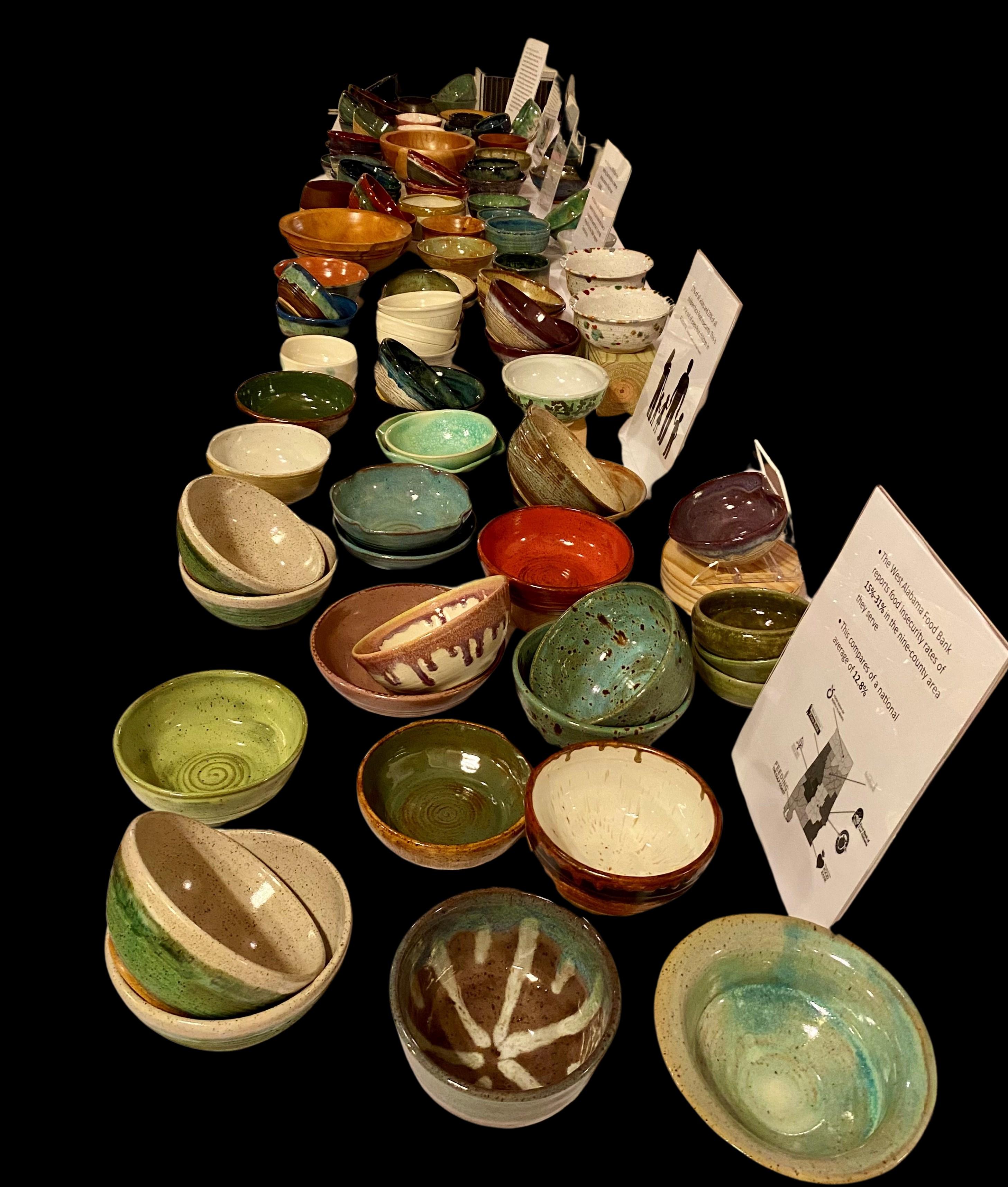


Continuedfromthepreviouspage
Our church is small, and our goal for this first event was to raise enough money to fund thepurchaseof beans and rice for one month. What we experienced was so much more! The empty bowls event was very meaningful to our congregation, driving home the reality of hunger and food insecurity in our community. The event strengthened our commitment at St. Matthias to continue to make a difference in the fight against hunger, and also raised enough money to pay for the next three months of our beans and rice ministry. Whata blessing!



St Matthias plans to host an annual empty bowls event each fall. More pottery bowls are being made as you read this article in preparation for 2024. We hope to grow the event into the community for our next empty bowls fundraiser. How to do this is the current topic of discussion. One idea is to invite the other Episcopal churches in Tuscaloosa to join us in an empty bowls lunch after church services. Stay tuned for further information as we plan our next emptybowls event.

LearnmoreaboutSt.MathiasbyscanningtheQR code.Interestedinhelping with their beans and rice project? Join them on the thirdSundayeachmonth.Followingworship,theyheadtotheparishhalltopack beansandricefortheWestAlabamacommunityandshareinapotlucklunch.
Throughout our diocese, parishes are making a profound impact on their communities, thanks to the Parish-Based Outreach grants awarded by the Department of Mission and Outreach. Last year, 13 parishes received grants, showcasing the diverse range of initiatives aimed at addressing critical needs. In 2023, the Episcopal Diocese increased its outreach grantfunding to$65,000, reflecting an 18% increasefrom the$55,000awarded in 2022. Part of the money used to fund these gifts comes from the annual Easter Fund. Moreinformation about theEaster Fund andways togivecan befound on page31.
Thesegrantshave become catalysts for transformativeoutreach, enablinglocal parishes to initiate programs that extend a helping hand to those in need. On previous pages of this issue of The EpiscopalianDr. Carol Lammon shared the success of the Beans and Rice Ministryat St. Matthias in Tuscaloosa, providing sustenance to 772 households over four months. Despite funding challenges, the church organized an Empty Bowls fundraiser, demonstrating a commitment to addressing food insecurity and community engagement. The Beans and Rice Ministry has becomea central focus, earningthechurch themoniker "Beans and RiceChurch"in Tuscaloosa.
Another example is St. Peter's Episcopal Church in Talladega, where the Diaper Row Initiative has transformed an emptyroom intoa haven for families in need. Theinitiativehas distributed an astounding 30,180diapers and1,175 Pull-Ups to over 650 babies. This effortnot onlyaddresses a criticalneed but has alsocreated a beloved communitywithin Talladega County.
These stories represent just a glimpse into the transformative initiatives supported by the ParishBased Outreach grants. From respite nights for foster families to day programs for cognitive or neurosensory divergent adults, each project reflects a commitment toserving the diverse needs of communities across Alabama. The increased grant funding in 2023 signifies a growing dedication to fostering positive change and creating a lasting impact. The Episcopal Diocese's investment in these initiatives underscores the belief that through collective efforts, they can truly make a difference in the lives of those they serve which reflects the love ofJesus for all.
2024 Parish-Based Outreach Grant applications are open now, and we hope your parish will apply.
Questions? Contact ClaireCotten at ccotten@dioala.org.

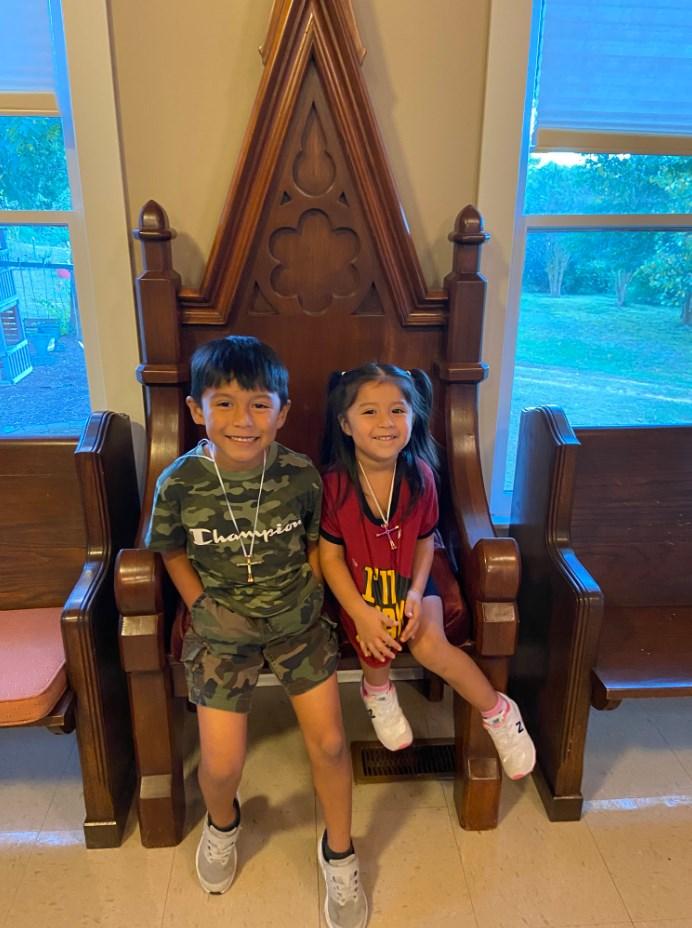



HostedByBishopCurry
April13,9-noon
ChurchoftheAscension,Vestavia

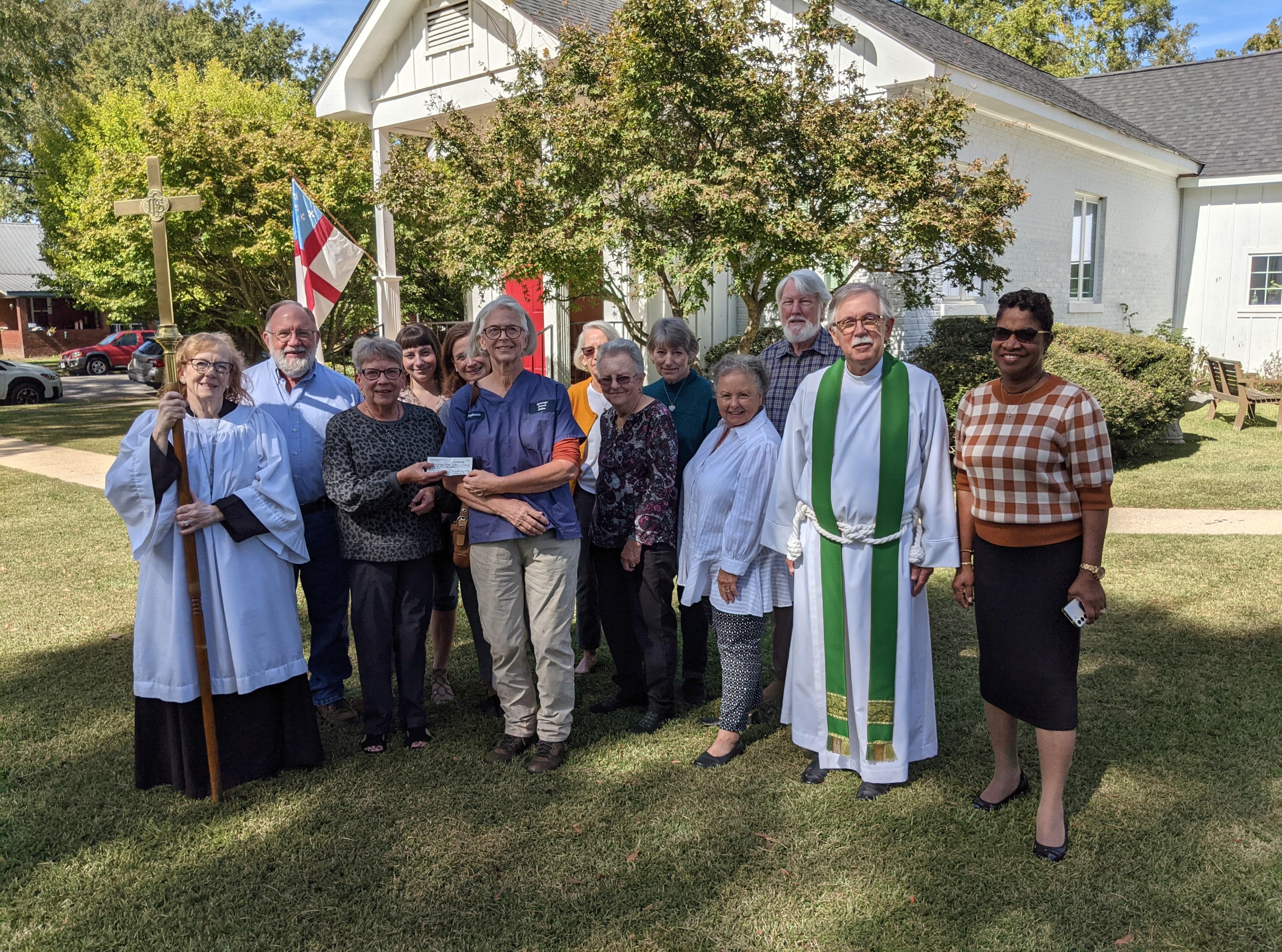
Inspired bySt. Frances ofAssisi’s life andwork, St. Andrews Episcopal Church observed his feast dayby donating $600.00 tothelocal animal shelter. Themoneywas raised bythe parishioners.
St. Andrews is a small, welcoming parish andtheywould lovefor you to visit them. For serviceinformation pleasecall thechurch officeat (256)
PicturedatrightareFather BillBlackerbyand members ofSt. Andrews. Thecheck was presented byJoan Ludwig toStephanieEngle, manager oftheshelter.




Dear friends:
TheEaster Fundis awellspringofstrength for our diocese, fostering unityin our shared mission andministryas theEpiscopal Church in Alabama. Over several decades, faithful peoplelike you haveseized theopportunitytodirectlyparticipate in our collective work.
This supporthas played a crucialrolein revitalizingparishes, supporting ministries for children andyouth, andproviding seed funding for impactful parish-based outreach projects. Moreover, theEaster Fund empowers our bishops toextend support toclergyfamilies in distress. All ofthis isachieved without anyoverhead costs except for theexpense ofthisannualappeal.
As wepreparetocelebratetheemptytomb, I extend aheartfelt invitation for you tojoin mein contributingtotheEaster Fund. Whilea suggested gift of$3.50 per dayduringtheGreatFiftyDays ofEaster isrecommended, anyamount you choosetocontributewill begreatlyappreciated. Thankyou for standing with me inrespondingtotheneeds of others this year.
In thelove oftherisen Christ, Bishop Curry
TheEasterFund isdedicatedtoChristian mission,including:
Supporting congregational vitality and leadership development Ministry with children and youth or to those who are poor or in crisis Care for our clergy and their families in challenging situations
Lastyear,yourcompassionategivingsupportedtwotransformationalgrantprograms withinourdiocese,Renew&Refresh,and parish-basedOutreachGrants.
I/We offer this gift to the Easter Fund so Bishop G may respond to the needs of the coming year, especially for parishes, youth, children, the poor, the lost, and those in need of food and shelter.
Name/s
Phone _____________________________
Address
Email _______________________________________
City/ State/ Zip
____ $175 ($3.50 per day for the Great Fifty Days of Easter)
Other amount $
____ I have remembered my parish and/or the Episcopal Church in Alabama in my will Give online at www.dioala.org or scan the QR code to the left with your phone’s camera. Choose “Easter Fund” from the drop down menu. Checks may be made payable to the Episcopal Church in Alabama with “Easter Fund” in the memo line, and mailed to: 521 North 20th St., Birmingham, AL 35203-2682.

Additional Giving Options: ____ I would like information about including the Episcopal Church in Alabama in my estate plans. ____ I would like information about gifts of securities.




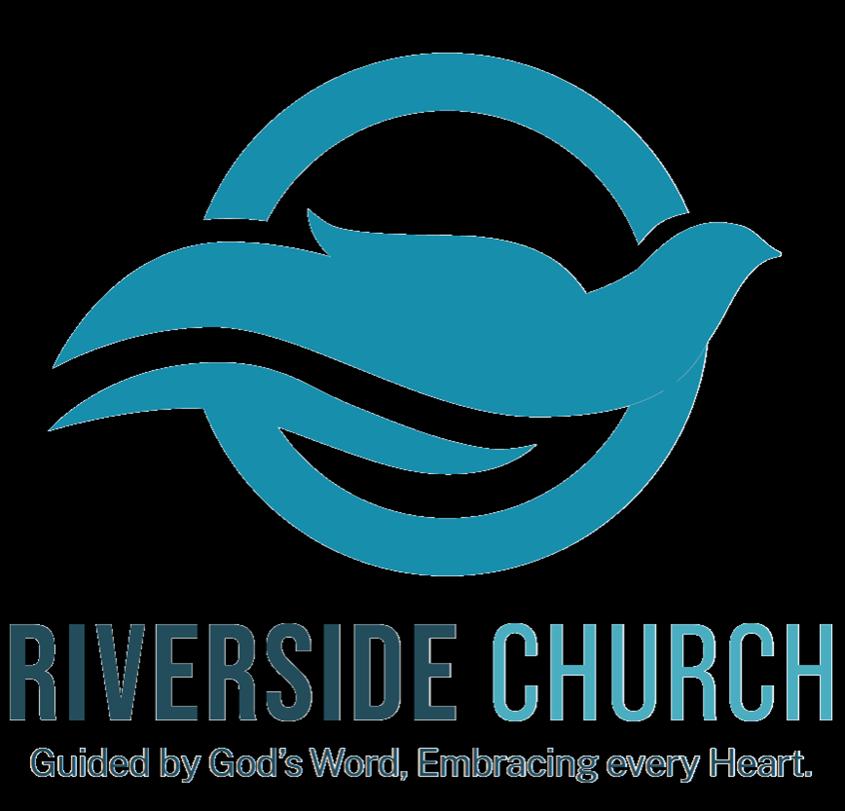
The Episcopal Church in The Diocese of Alabama
Mailing address: Carpenter House, 521 North 20th Street, Birmingham, AL 35203–2682
Bishop: The Rt. Rev. Glenda S. Curry
Assisting Bishop: The Rt. Rev. Brian N. Prior
The Alabama Episcopalian
Debbie Donaldson, Editor/Graphic Design
Volume 109, Number 41
1st Quarter, 2024
USPS 070-910
ISSN 1041-3316
Periodical postage paid
POSTMASTER: Please send address corrections to Liza Lee Horton, The Alabama Episcopalian, 521 North 20th Street, Birmingham, AL, 35203-2682. The Alabama Episcopalian is published quarterly. Please send stories and photographs (full color, at highest resolution possible) to Debbie Donaldson, ddonaldson@dioala.org. The submission deadlines for each issue are February 1, May 1, August 1, and November 1. Parishes and individuals, please send all address changes or additions to Liza Lee Horton, lhorton@ dioala.org or Carpenter House, 521 North 20th Street, Birmingham, AL 35203–2682.